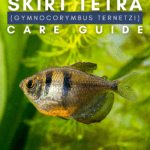The Black Skirt Tetra makes an excellent addition to a community aquarium of peaceful freshwater fishes.
Although these fish lack the bright, vibrant colors of some of the other popular tetra species, their darker, striped looks can work well in a dramatic monochrome setup. And it’s the fish’s somber, dusky color that gives it another common name; the Black Widow Tetra.
Read this guide to learn how to care for the beautiful, enigmatic Black Skirt Tetra.
Black Skirt Tetra – Overview
Scientific Name
Gymnocorymbus Ternetzi
Common Name (species)
Black Skirt Tetra, Black Widow Tetra, Petticoat Tetra, Blackamoor
Family
Characidae
Origin
Found in South America, including the Paraguay River Basin, Argentina, and Brazil
Diet
Omnivore
Care Level
Easy
Activity
Active, schooling fish
Lifespan
3 to 5 years
Temperament
Peaceful
Tank Level
Swims in all areas of the water column, but primarily the middle
Minimum Tank Size
15 gallons
Temperature Range
Tropical 70° to 85° Fahrenheit
Water Hardness
4 – 8 dKH
pH Range
6.0 to 7.5
Filtration/Flow Rate
Prefers a moderate flow with excellent filtration
Water type
Freshwater
Breeding
Egg layer, moderately easy to breed
Compatibility
Peaceful community species
OK, for Planted Tanks?
Safe with plants
Origins
The Black Skirt Tetra was first described in 1895 by Boulenger.
These attractive tetras are widely distributed across South America, specifically the Paraguay and Guapore River Basins, Argentina, and Brazil. These fish are not currently listed on the IUCN Red List, as their numbers in the wild are plentiful, and most of the specimens you find for sale in fish stores are captive-bred.
Natural Habitat
In nature, the Black Skirt Tetra inhabits the upper areas of the water column, typically being found in small streams, creeks, and river tributaries, where the water is slow-moving and well shaded by overhanging trees.
The fish are omnivorous, feeding on plant matter, small crustaceans, insects, and worms.
Appearance
Black Skirt Tetras have the characteristic tetra body shape, being taller at the front of their body, but the rear end tapers markedly toward the caudal.
The fish’s unusual shape is further enhanced by the shape of its fins. The dorsal fin is tiny and square, while the tail fin is forked and thin. But it’s the anal fin that’s most eye-catching, extending from the center of the fish’s body all the way to the caudal and thickening at the fish’s belly.
Monochrome
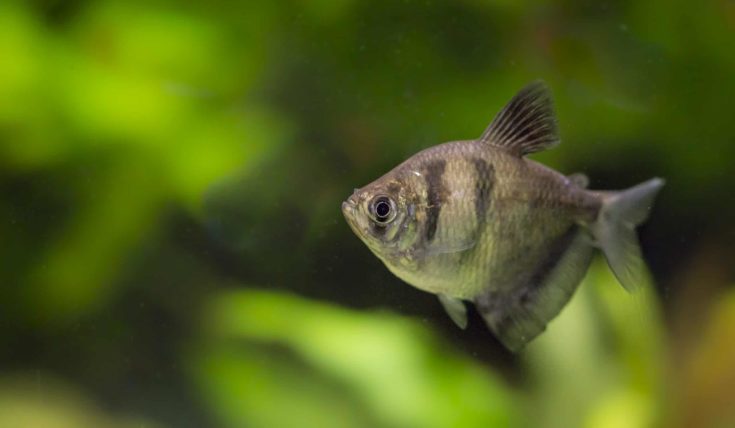
The Black Skirt Tetra has a grayish-silver, almost translucent body. The color fades almost to black at the middle of the body, and there are two vertical black bands on the front of the body.
The finnage is typically black or charcoal gray, being translucent with very small rays.
Boys or girls?
Although both sexes look pretty much the same, female Black Skirt Tetras are usually a little larger than males and are plumper when in breeding condition.
Often, males have a wider anal fin than females.
Other varieties
You can also find a long-finned variety of these fish called the Black Skirt Hifin Tetra or Longfin Black Skirt Tetra that was developed in Europe.
Other developments of the species include naturally colored strains that appear in blue, white, and pink, all of which can be found fairly easily either in fish stores or online. However, there are some artificially dyed variants available, too, which we don’t recommend for ethical reasons.
Size
A full-grown Black Skirt Tetra measures around 3 inches in length.
Life Expectancy
Black Skirt Tetras live for between 3 to 5 years in captivity, although some have reportedly lived longer than that.
Activity Level/Temperament
Black Skirt Tetras are active schooling fish that are generally very peaceful characters.
The fish’s one downside is their typical tetra habit of fin nipping.
Compatibility and Tankmates
These are schooling fish, so I recommend that you keep a group of at least five individuals or more if you have a large setup. The fish will be more confident in the safety of numbers, and they will probably have a longer lifespan and better health.
Tank Mates
Aggressive fish should be avoided, as should nippy fish that might be drawn to the Black Skirt Tetras long fins. On the flip side, you should avoid adding fish with long, trailing fins to your community that could be targeted by the Black Skirt Tetras.
Suitable tank mates for these fish could include:
- Corydoras catfish
- Harlequin rasbora
- Chili rasbora
- Celestial Pearl Danio
- Dwarf gourami
- Bolivian ram
Feeding
All fish species do best when fed a high-quality, balanced, nutritious diet.
Don’t waste your hard-earned cash on cheap fish food! Although that huge tub of flakes might appear to be of good value, the food is most likely packed with padding that contains no nutritional value.
What to Feed Your Black Skirt Tetras
Black Skirt Tetras are omnivores, meaning that they eat both plant matter and meaty protein.
In nature, these fish eat insects, insects, tiny crustaceans, worms, and some vegetation. In the captive environment, these are not fussy feeders, happily consuming tropical fish flakes, pellets, frozen bloodworms, daphnia, brine shrimp, and the like.
Although your fish will appreciate the addition of some live foods in their diet as a treat, you must remove the food from the liquid it comes in, as that can contain bacteria and parasites.
For the same reason, you should never take live food from the environment! We recommend that you use frozen meaty protein foods instead.
How Much and How Often to Feed
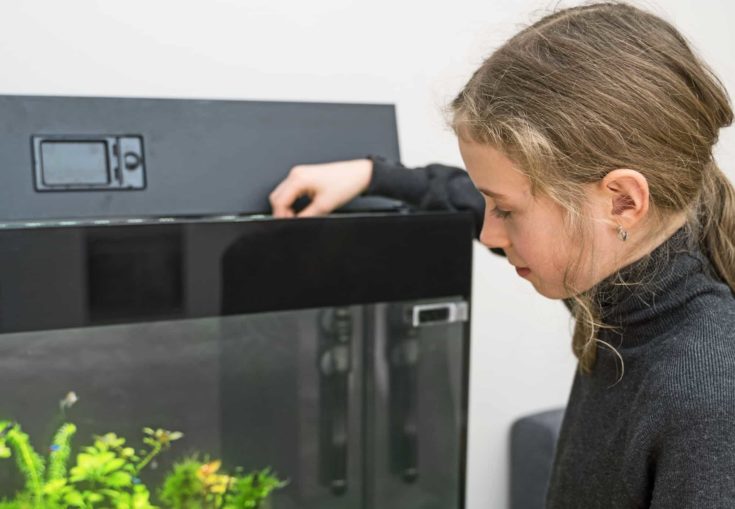
Feed your Black Skirt Tetras two or three times daily.
Only give your fish what they will eat in a few minutes. Be careful not to overfeed your fish. Uneaten food will sink into the substrate, where it will gradually decompose and pollute the water.
Tank Requirements
Tank size
I recommend a tank size of 15-gallons for a small school of Black Skirt Tetras, although larger is better if possible.
If you’re planning on keeping a community of different species, a 20-gallon tank is a better choice. That provides plenty of space for these active fish to swim and reduces the risk of overcrowding your fish, which can stress your fish and create health problems.
As these are lively, active fish, a long tank provides more swimming space than a tall one and provides a larger surface area for valuable gaseous exchange to take place, helping to oxygenate the water.
These tetras can jump, so a cover slide or well-fitting lid for your aquarium is essential.
Tank Setup
Substrate
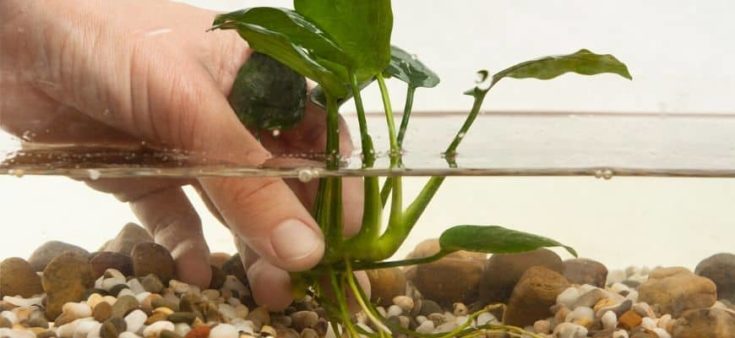
Black Skirt Tetras don’t have any specific requirements when it comes to the substrate. However, a dark substrate replicates the fishes’ natural environment where the floor is covered with leaf litter.
A sandy substrate or river gravel both works well.
Decoration
These fish suit a natural-looking habitat, so use driftwood, rocks, and twisted roots to create an attractive aquascape but be sure to leave plenty of swimming space.
In nature, the fish live in a blackwater environment, where the water is stained a light brown by fallen leaves that drop from the overreaching canopy above. You can add some dried leaves to the tank to recreate that look.
Subdued lighting helps to display the Black Skirt Tetra’s coloration to the best effect.
Living plants look good and help to keep the environment healthy by absorbing nitrates and CO2 from the water and giving off oxygen as part of the process of photosynthesis.
Habitat Requirements
Filtration
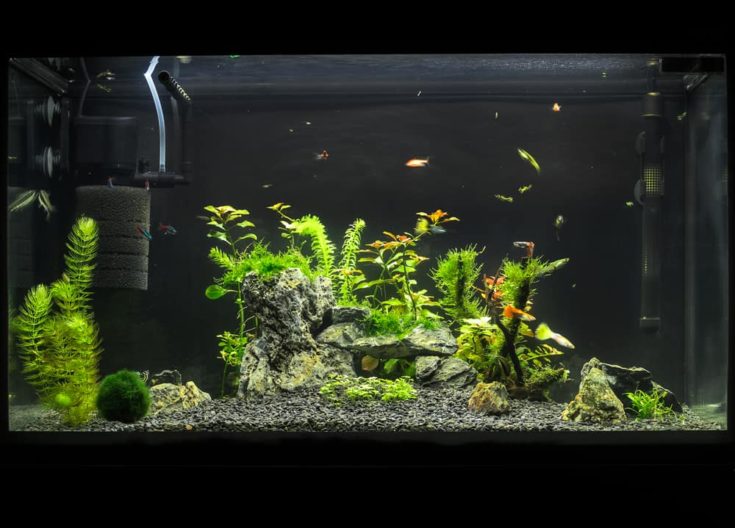
These fish need safe, clean water in which to thrive, so an efficient, well-maintained filter system is a must.
In nature, the water in which these tetras live is slow-moving, so take care to redirect or buffer the flow, using plants or items of décor.
Water Parameters
Water Temperature
Black Skirt Tetras are tropical fish that need a water temperature of between 70° and 85° F, ideally in the middle of that range.
Water Hardness and pH Range
The aquarium water should have a pH of between 6.0 and 7.5, with a water hardness of 4 to 8 dKH.
Lighting
Black Skirt Tetras like relatively dim lighting, so choose an LED lighting unit that you can adjust to suit your requirements and select plants that will grow in subdued light conditions.
Tank Maintenance
As well as installing an efficient filtration unit, you must perform weekly partial water changes of at least 30% to keep nitrate levels down.
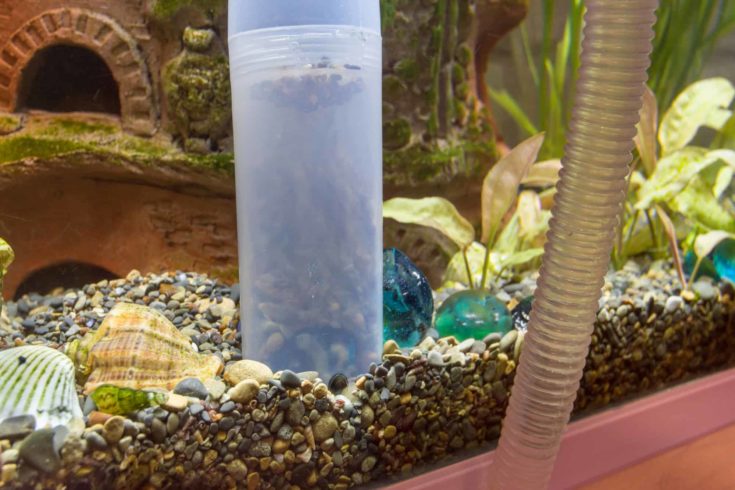
As part of your water change routine, vacuum the substrate, underneath items of décor, in the tank corners, and around plants to get rid of uneaten food, fish waste, and decaying plant material.
Use an algae magnet to clean the viewing panes but try not to remove the bacteria and biofilm that form an essential part of your biofilter setup.
Once a month or so, rinse the filter media in dirty tank water, and replace the media when necessary, as per the manufacturer’s guidelines.
Setting Up the Aquarium
Lay out everything you need to set up the aquarium, including:
- Sand, or dark river gravel substrate
- LED lighting unit
- HOB filtration system
- Water conditioner
- Heater
- Aquarium thermometer
- Twisted roots, smooth rocks, driftwood
- Dried almond leaves
- Plants
How to Set up Your Aquarium
- Wash away dust from the substrate under running water.
2. Add two or three inches of sand or gravel into your fish tank. Set an upside-down bowl on top of the substrate.
3. Install the filter and heater, but don’t switch them on just yet.
4. Add dechlorinated tap water to the tank, pouring the water slowly over the upturned bowl so that you don’t scatter the gravel.
5. It’s essential that the water contains a small amount of ammonia to trigger the nitrogen cycle in your biological filter media. So, you must “seed” the water. Do that by adding a handful of gravel from a mature aquarium, a few pinches of fish food, or a drop or two of pure ammonia.
6. Rinse away dust from your chosen tank decorations and arrange them in your tank.
7. If you’re using living plants, trim off broken or dead leaves and stems. Give the plants plenty of space between each stem so that they have the scope to grow and spread.
8. Switch on your heater and filter. Live plants need light to photosynthesize, so put the lighting unit on for eight to 10 hours every day.
You must now wait for the tank to “cycle” before adding any fish. That time allows nitrifying bacteria to colonize the biological filter media and surfaces within the tank. Test the water every couple of days until the levels of ammonia and nitrites are zero and nitrates are below 20ppm.
If necessary, allow more time for the process.
Health and Disease
Provided that you feed your fish correctly, keep the tank clean, and maintain the filter media, Black Skirt Tetras are quite hardy fish.
Signs of Good Health
These fish are active creatures that should swim in all areas of the tank, spending much of their time shoaling.
Red Flags
Here are a few red flags that could indicate potential health conditions, including:
- Loss of appetite
- Inactivity
- Not schooling with tank mates
- Ulcers, sores, or red patches on the skin
- Flicking or rubbing against the gravel or tank decorations
Common Health Issues and Treatment
Health Issue
Ich (White Spot Disease)
Symptoms or Causes
Ich is caused by a parasite called Ichthyophthirius multifiliis.
Fish with White Spot flick against tank decorations. Within a few days, a scatter of white spots appears all over the gills, body, and fins.
Suggested Action
Increase the water temperature to 82o F for three days. Use Ich medication to treat the water.
Health Issue
Flukes
Symptoms or Causes
Flukes are parasites that fasten themselves to the gills or body of infected fishes. Fish will secrete excessive body mucus and rub against tank decorations.
Suggested Action
Treat the water with an antiparasitic treatment.
Health Issue
Fungal infections
Symptoms or Causes
White cotton-like growths on the head and body.
Suggested Action
Quarantine infected fish. Treat with antifungal medication.
Health Issue
Bacterial infections
Symptoms or Causes
Skin ulcers, sores, red areas, torn and bloody fins.
Suggested Action
Treat the water with antibacterial medication.
Breeding
Black Skirt Tetras are egg-layers.
Set up a 10-gallon spawning tank, including a spawning mop, and cover the bottom of the tank with a fine-gauge net to prevent the fish from eating the eggs.
Choose a healthy bonded pair of fish and add them to the spawning tank. Give the fish high-protein live foods to bring the couple into breeding condition. The female will drop up to 1,000 eggs, scattering them throughout the tank. The eggs sink to the bottom of the aquarium, falling through the netting where they are safely out of reach of the adults.
When spawning is complete, return the adults to the main aquarium.
The eggs will hatch after 24 to 36 hours. The fry feeds on the egg sac for the first few days, after which you can feed them infusoria or fry food. In a week or two, the fry will be large enough to take baby brine shrimp.
Availability
You can buy Black Skirt Tetras at most fish stores for a few dollars per fish. The naturally colored variants can usually be purchased online and are slightly more expensive.
Product Recommendations
- Water conditioner/dechlorinator
- Algae magnet
- Aquarium thermometer
- Aquarium vacuum
- Books on keeping tropical fish
- Filtration system
- Aquarium (minimum size 15 gallons)
- Heater
- High-quality tropical fish flakes, pellets, frozen foods
- LED lighting unit
- Plants
- Smooth stones, driftwood, twisted roots
- Sand or dark gravel substrate
In Conclusion
I hope you enjoyed our care guide for the beautiful Black Skirt Tetra.
These easy-to-care-for, active, peaceful fish make a wonderful addition to a community tank. Do you have Black Widows in your setup? What tank mates have you chosen for them? Tell us in the comments box below!
And, please remember to share our guide if you enjoyed it.
